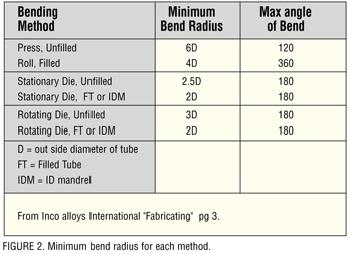


But in reality, the basic principles have remained the same for decades. Many call tube bending a black art, a mysterious process with unavoidable trial and error.


for C, C-Mn and C-Mo steels, no subsequent heat treatment is required,.3 times the external diameter for cold bent steel pipesĪ) The pipes are to be bent in such a way that, in each transverse section, the difference between the maximum and minimum diameters after bending does not exceed 10% of the mean diameter higher values, but not exceeding 15%, may be allowed in the case of pipes which are not subjected in service to appreciable bending stresses due to thermal expansion or contraction.ī) The bending is to be such that the depth of the corrugations is as small as possible and does not exceed 5% of their length.Ī) In the case of hot bending, all arrangements are to be made to permit careful checking of the metal temperature and to prevent rapid cooling, especially for alloy steels.ī) Hot bending is to be generally carried out in the temperature range 850☌ – 1000☌ for all steel grades however, a decreased temperature down to 750☌ may be accepted during the forming process.Ĭopper and copper alloy pipes are to be suitably annealed after cold bending if their external diameter exceeds 50 mm.Ī) After hot bending carried out within the temperature range specified in, the following applies:.twice the external diameter for copper and copper alloy pipes,.Unless otherwise justified, the bending radius measured on the centerline of the pipe is not to be less than: The bending process is to be such as not to have a detrimental influence on the characteristics of the materials or


 0 kommentar(er)
0 kommentar(er)
